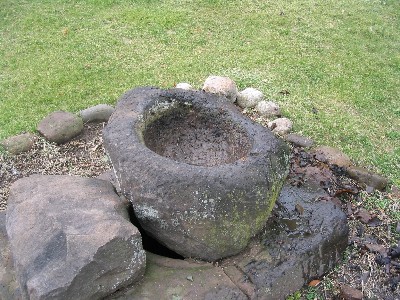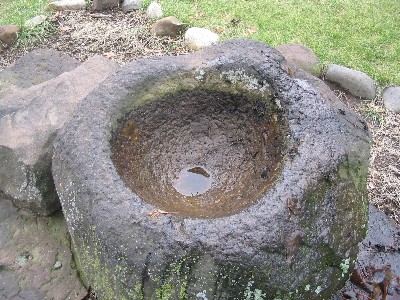| Author | Message | ||
Joe R. Citizen Username: Ragnatela Post Number: 248 Registered: 6-2004 |
I tried this here a couple of years ago, but no one seemed to have any info. On my property in Mplwd is a large brown stone situated on top of a rectangular stone which has a large round opening in it (obviously a well or cistern of some kind.) The stone on top is all scooped out and it actually collects a good amount of water after a rainfall (I would guess a quart or two). When we bought the house, the description referred to the feature as "Indian Grinding Stone". Does anyone think this is something that a prior owner acquired and brought here to display as a garden feature? Does anyone think there is the slightest possibility that the stone has archeological significance? | ||
Bob K Supporter Username: Bobk Post Number: 10267 Registered: 5-2001 |
Who knows? I would suggest photographing it carefully and sending the pictures to a university with a good Native American studies department. Maybe Arizona? I know of two water powered grist mills in the area. Pierson's Mill on Valley is a no brainer, but there was also one on Glen Avenue in Millburn. The old grinding stone is part of the driveway of the house that stands there now and you can see the remains of the mill in the side yard. | ||
bill671 Citizen Username: Bill671 Post Number: 292 Registered: 6-2002 |
Native Americans did populate this area, and were known to the early white settlers. Tuscan school is named for a local chief. They were here, they had to eat, so it would not be out of the question for it to be authentic. | ||
kmk Supporter Username: Kmk Post Number: 907 Registered: 5-2001 |
Contact the Mashuntucket-Pequot Museum in Connecticut (near Mystic). They have a research department. They have an incredible museum and they chronicle all the New England tribes. | ||
tom vilardi Citizen Username: Tlv350 Post Number: 34 Registered: 1-2004 |
Joe, Contact the Durand Hedden House/Maplewood Hist. Society. I think Bob Grassmere had a stone bowl with grinding stone he dug up in his garden years ago and a few other things from pre-european interaction Natives. There's a chance they may be able to direct you to someone who identified Bob's stuff. Tom | ||
Joe R. Citizen Username: Ragnatela Post Number: 250 Registered: 6-2004 |
thanks | ||
John Caffrey Citizen Username: Jerseyjack Post Number: 11 Registered: 11-2005 |
Most likely it is of Euro. based origin. The N.J. based tribes would spend time chisling net sinkers, spear points and ax heads. If you have seen any of these, they took a vast amount of time to fabricate. Furthermore, most woodland natives changed their habitat every 10-15 years after they exhausted the local game supply. I can't imagine spending time to build a grinding wheel and then have to move it 50 miles or make a new one at the new site. | ||
Joe R. Citizen Username: Ragnatela Post Number: 254 Registered: 6-2004 |
Maybe I mischaracterized it. It's not a wheel. It's a boulder with the top scooped out. I imagine someone putting grain into it and grinding it mortar and pestel style with a stone tool. | ||
Lizziecat Citizen Username: Lizziecat Post Number: 1029 Registered: 5-2003 |
Take a picture of it and send it to Dr. Herbert Kraft at Seton Hall. He's an expert in the Lenape, who were--and are--one of New Jersey's local groups. He's written several books on the Lenape, which are, I'm sure, available at our local libraries. | ||
John Caffrey Citizen Username: Jerseyjack Post Number: 16 Registered: 11-2005 |
Maybe so, given the new information. Still, I would like to know if the N.A.'s in our area ever ground anything. The main crops in our area were beans, squash and corn. (The Iroquois "Three Sisters"). I don't know if any tribes or nations ground grain. As per the prior suggestion, call the museum in Connecticut and ask if the corn was ground. I believe the town would be Uncasville, Conn. | ||
Eponymous Citizen Username: Eponymous Post Number: 16 Registered: 6-2004 |
Take a picture and post it here. :-) | ||
Bob K Supporter Username: Bobk Post Number: 10320 Registered: 5-2001 |
Native Americans in the east grew corn and ground it into corn meal. | ||
Joe R. Citizen Username: Ragnatela Post Number: 257 Registered: 6-2004 |
I'll photograph it tomorrow and post it. | ||
Joe R. Citizen Username: Ragnatela Post Number: 258 Registered: 6-2004 |
Here are the pics. What do you think?   | ||
Hank Zona Supporter Username: Hankzona Post Number: 5160 Registered: 3-2002 |
The American Indian Museum in dowtown NYC, a satellite of the Smithsonian, has a large research department..I believe they even have online research access (one of my favorite smaller museums in one of my favorite NYC buildings architectually). Try contacting them...they have a website or you can pop in there some time. | ||
John Caffrey Citizen Username: Jerseyjack Post Number: 24 Registered: 11-2005 |
That is a really neat artifact. JC | ||
Joe R. Citizen Username: Ragnatela Post Number: 259 Registered: 6-2004 |
I agree. Question is...what the heck is it? | ||
John Caffrey Citizen Username: Jerseyjack Post Number: 29 Registered: 11-2005 |
O.K. My friend and daughter corrected me. The most common thing to be ground in such a device was ACORNS. Yes, they are edible after the tannic acid is leached out of them. Also, corn and grass grains could have been ground. JC | ||
Greeneyes Citizen Username: Greeneyes Post Number: 811 Registered: 8-2001 |
Joe, Did you ever find out what the heck it is? | ||
Dennis J O'Neill Citizen Username: Plungy Post Number: 46 Registered: 6-2005 |
I believe the native americans out west called them metotaes. Not sure if that is the correct spelling. Heard this from an Indian guy while spending time on the Morongo reservation in Banning Cal. in the 70s. | ||
Dennis J O'Neill Citizen Username: Plungy Post Number: 48 Registered: 6-2005 |
Metate. Thanks Google. |